Apple iPad mini with Retina Display: Reviewed
by Anand Lal Shimpi on November 16, 2013 8:00 AM ESTThe SoC
The iPad mini with Retina Display rounds out the three platforms that use Apple’s A7 SoC. Although both the iPad Air and iPhone 5S use the A7, the mini’s implementation is closer in nature to the iPhone. The iPad mini’s SoC has always used the same package-on-package (PoP) assembly as the iPhone, with DRAM stacked on top of the SoC itself (1GB in this case). The benefit is obviously a reduction in board area, the downsides have to do with cost and thermals. That’s the first similarity between the mini’s A7 and the iPhone’s A7.
The second is one of frequencies. While the iPad Air’s A7 runs its two Cyclone CPU cores at up to 1.4GHz, the SoC in the iPad mini and the iPhone 5S runs at up to 1.3GHz. That might sound like a minor difference, but it’s far more pronounced when you look at what happens to frequency when you’re running heavy workloads.
Once again I turn to a fairly heavy CPU workload to plot performance over time. This is a multithreaded workload, slightly modified from what we used in the iPad Air review, designed to make the CPU cores consume max power. The scale is linear and the workload is the same across all devices, so what you’re effectively looking at is a graph of thermally bound CPU performance over time across all three A7 implementations:
Being the largest device (and the only device with a metal heat spreader and no DRAM stacked on top), the iPad Air obviously maintains the highest frequencies for the duration of the test. The iPhone 5S, with a significant reduction in internal volume (and a PoP SoC) reduces its CPU frequencies early on in order to keep skin temperature down and properly manage thermals. The iPad mini with Retina Display falls between the two, with its performance curve more closely following that of the iPhone 5S.
Although the mini has a similar max operating frequency to the iPhone 5S, it is a faster device thanks to it being less thermally constrained. Similarly, the iPad Air can be much faster than its clock speed would otherwise imply. If you’re wondering why Apple has been so focused on building its own SoCs and CPU architectures, this is the reason why. There’s a fixed amount of power you can dissipate in the form of heat in these mobile devices while still maintaining a good user experience. Performance per watt is the gating metric for success in mobile, and shipping high IPC/low frequency dual-core SoCs at 32/28nm is the best optimization available to a company like Apple today.
As you’d expect, our browser based CPU tests show the mini’s A7 performing in between the iPhone 5S and iPad Air. None of these tests are anywhere near as stressful as our thermal test from above, so we don’t see exaggerated differences in performance between the platforms. For most, I suspect you won’t notice a huge performance difference between the mini and Air. Those who are heavier users (e.g. audio mixing, 3D gaming, etc…), there will be a performance difference between the two iPads.
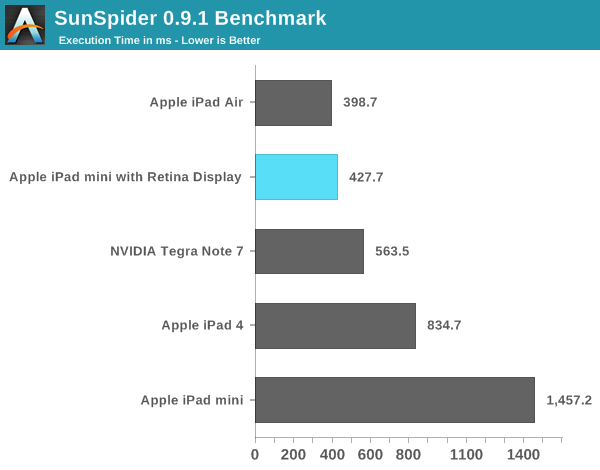

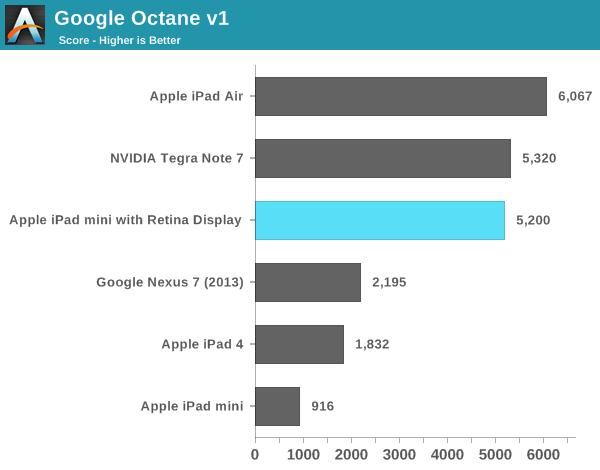
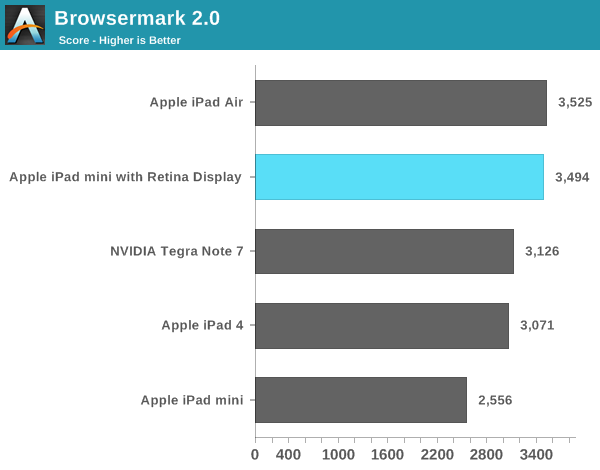
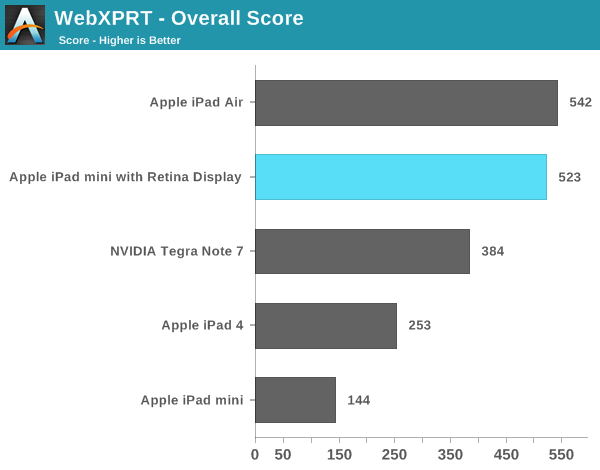
Compared to the first generation iPad mini, the new model is in a completely different performance league. Keep in mind the first mini used Apple’s A5 SoC based on an ARM Cortex A9. That’s the same single threaded performance as what’s in an iPhone 4S, and under iOS 7 it’s clearly running into some performance limits. The new mini with Retina Display however is a completely different animal. It’s fast.
Even comparing to the 4th generation iPad, the new mini is noticeably quicker.
Memory Bandwidth
Looking at the iPad mini’s memory bandwidth curve, we see it tracks very closely with that of the iPhone 5S. This is a slightly modified version of our previous bandwidth test, and you can see peak usable memory bandwidth (from the CPU’s perspective) of around 10GB/s. The ~12GB/s area right before you get out to main memory is bandwidth to the A7’s 4MB system-wide cache that sits after the shared L2 and the memory controller. This cache appears to service CPU, GPU and ISP requests at least.
GPU Performance
I believe the A7’s PowerVR G6430 GPU runs at around 450MHz. This frequency appears unchanged across all three A7 implementations. Once again, the big difference is how much thermal headroom exists in the platform which has an impact on overall performance.
Kishonti’s low level GPU performance tests back up my assertion that GPU frequency is fixed across all A7s. The iPad mini with Retina Display delivers equal performance to the iPad Air. The bigger news here is that nearly all of the GPU bound 3D tests seems to peg the mini and Air as equals. These are some pretty intense tests, but it looks like on the GPU side there’s no significant throttling when running at full tilt.
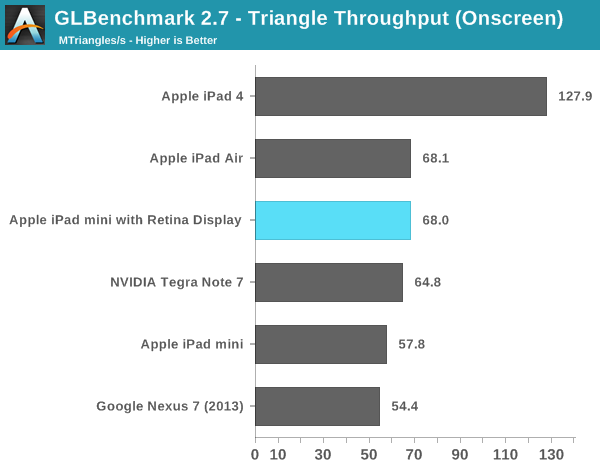

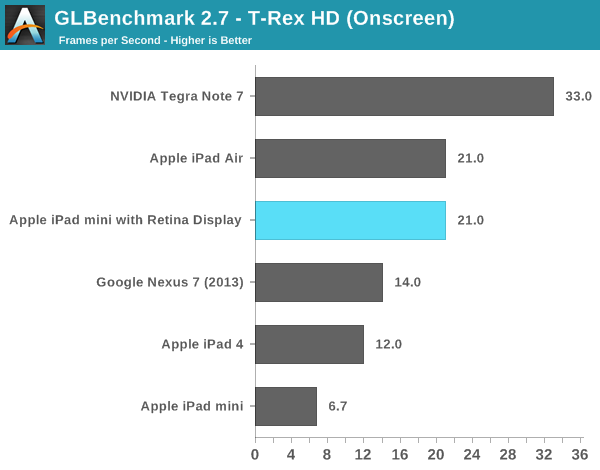

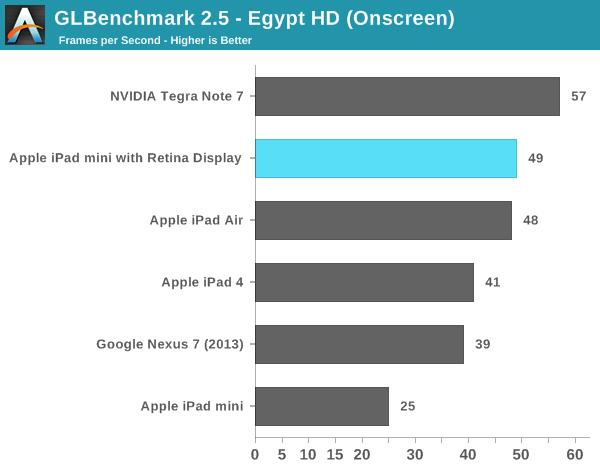
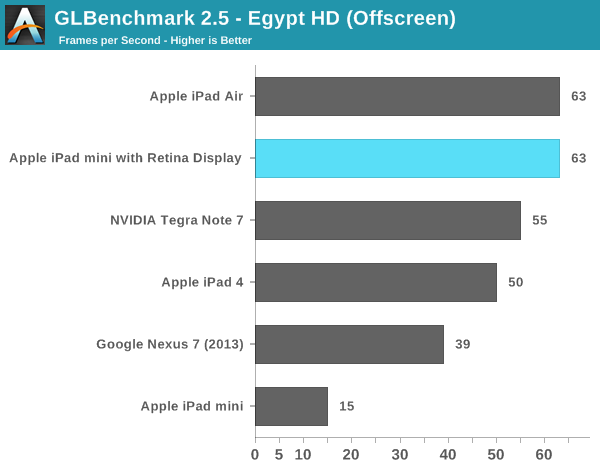
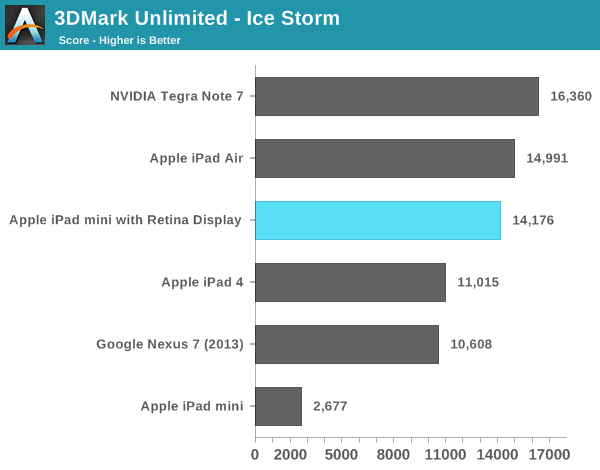
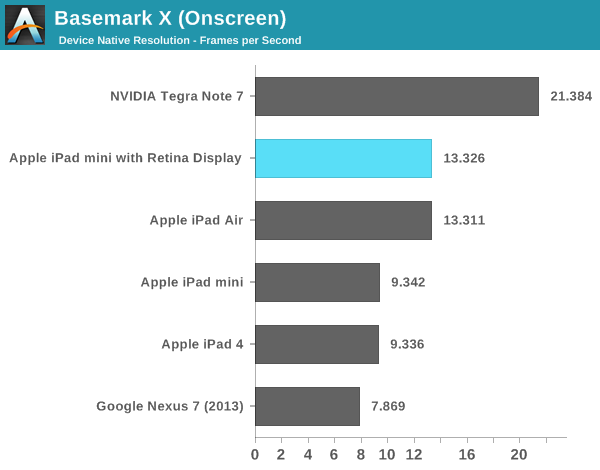
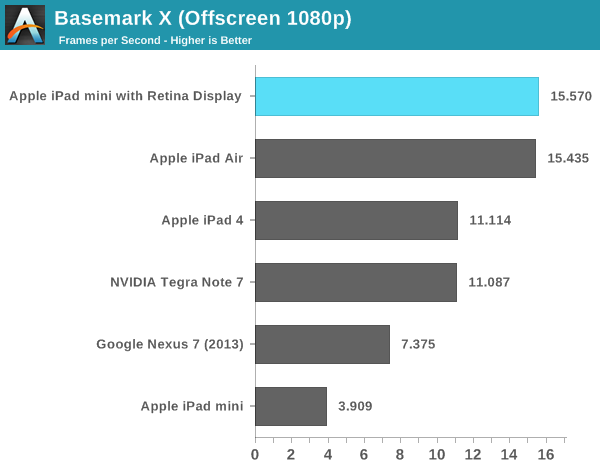
As I mentioned in our iPad Air review, despite having less peak theoretical memory bandwidth than the A5X/A6X, the A7 in the iPad mini never seems to regress in performance compared to even the iPad 4. Across the board the mini appears to be faster, more responsive and have more performance on tap than any prior iPad (big or small). The comparison to the original iPad mini is of course night and day. Even looking at lighter tests like the old GLBench Egypt HD benchmark, the iPad mini with Retina Display manages to be nearly twice as fast as the original mini - all while rendering 4x the number of pixels.


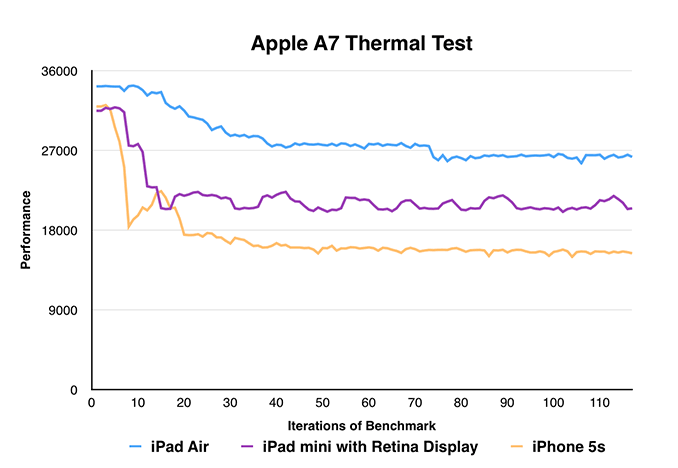
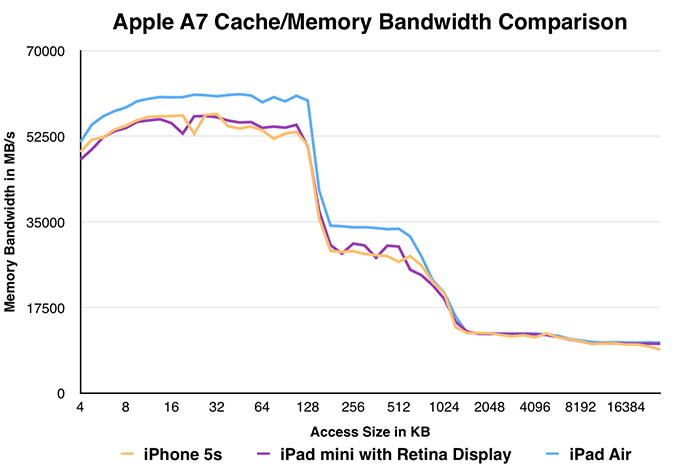








345 Comments
View All Comments
R0H1T - Sunday, November 17, 2013 - link
Too bad Apple fanbois need to be spoon-fed by this site & dozens like this one in order for'em to make an informed decision "to buy or not to buy" the latest iToy out in the market ):akdj - Sunday, November 17, 2013 - link
Sadly DBags like you wade though the review, 178 replies, and take the time to spew such drivel ONLY because your mother said "Hell No I'm not buying you one!! Get out. Get a job...buy one YOURSELF!"News. Flash. R0H1T....the iPad is no 'toy'. You certainly reveal your 12 maybe 13 year old age by calling it such. What was only a decade ago, even five years ago available only in lap or desktop form with two hours of batter life and spinning hard drives with less than a quarter the resolution has now become ubiquitous. Common place....and in many cases the ONLY computer many people need. Go on....feed you spider. Someday you'll be able to have one too
Grow. Up.
reggjoo1 - Sunday, November 17, 2013 - link
Let me get this out of the way, I think apple makes great tablets, but I won't leave android for ios. The Ipad mini, sounds great, and advances the game, hardware, and performance wise. I like android over ios, because you can make your device, your device. I can adjust how the memory performs, set permissions for my apps, change the look, and feel to my liking, etc.. Even if I see someone with the same model, brand, I know my android, is uniquely my own, you can't do that with apple, I like a os setup just for me, and look the way i want. Give apple it's props, but it's just not for me. In a few months, someone will come out with something anyway, I like the competition in mobile.tytung - Monday, November 18, 2013 - link
Easy, just jailbreak it, or wait until there's a jailbreak.hlovatt - Sunday, November 17, 2013 - link
Great review and amazingly quick after the device went on sale, it really must take a lot of time and effort to so comprehensively test a device. Great work.Pity that the iHater brigade are posting on AnandTech, the comments used to be so much more insightful. Rather than saying that Anand is biased for pointing out that 'a Nexus 7 isn't as good but is cheaper', it would benefit people who want to buy an Android tablet to say great product this is what I want for the next iteration of the Nexus. Competition is good, don't kill it.
Another alternative is that these people are paid to post negative comments on all good Apple reviews. If they are paid negative comments I hope they get found out and kicked off. That way we can all enjoy our geeking out without the painfully biased comments.
psyside1 - Sunday, November 17, 2013 - link
So this is why Nexus 5 review is not yet done, now its all clear.hlovatt - Sunday, November 17, 2013 - link
I think you are demonstrating that you are a one eyed iHater, e.g. in this very forum people are asking where reviews of the Apple MacBook Pro are. Does that make the site Dell biased? No, AnandTech have finite resources and such quality reviews take time so they unfortunately can't do everything and have to prioritise. Presumably they also rely on supply of product to review, they couldn't possibly afford to purchase everything they review.psyside1 - Sunday, November 17, 2013 - link
They cant afford? LOL!!!!!beggerking@yahoo.com - Monday, November 18, 2013 - link
exactly! i was wondering why Nexus 5 was not up while the the AIr went up the same day it was released.chubbypanda - Tuesday, November 19, 2013 - link
I'm afraid it's Brian, not Anand, who's working on Nexus 5 review.